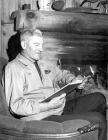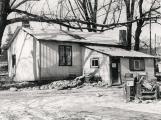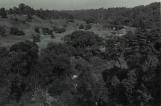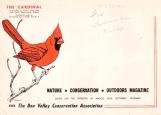1
In the post-war era, housing and industrial development threatened the Don Valley. A number of concerned individuals formed a volunteer association dedicated to the preservation of the sylvan and serene beauty of the Valley.3
Charles Sauriol (1904-1995) was a founder of the early Don Valley conservation movement. As a child, Sauriol had been captivated by stories and paintings of wildlife. He developed a passion and respect for the outdoors in his youth.Sauriol first encountered the Don Valley in the 1920s when it was a serene and lushly forested wilderness. Market gardens still stretched from Pape Avenue to Woodbine Avenue. Bayview Avenue, which ended at the edge of the Valley, was still a dirt road.
5
By 1927, Sauriol had become a part-time tenant on property located at the Forks of the Don. His log cabin retreat included a wild flower garden. Here he tapped maple syrup, canned fruit and vegetables, and kept a goat, pigs, as well as chickens.In 1947, he purchased the property outright. Seven years later Hurricane Hazel caused significant damage to the cabin and Sauriol decided to convert it into a Conservation Centre. Members of the Don Valley Conservation Association were involved in the restoration and conversion of the home, which became known as the Don Valley Conservation Centre Clubhouse.
The property was expropriated in the 1950s.
In 1957, Sauriol became the chairman of the Conservation Areas Advisory Board of the Metropolitan Region Conservation Authority. His dedication to conservation was recognized with many awards, including the Order of Canada and the Governor General's Award.
7
The Don Valley Conservation Association (DVCA) was a volunteer citizen group formed to preserve the Don Valley as a woodland park.Two hundred people attended the DVCA's inaugural meeting called by Charles Sauriol in December 1949. A bank account was opened with an initial deposit of $8.00.
Over the next few years, members of the DVCA
planted thousands of trees throughout the Valley, promoted anti-vandalism campaigns, built bird feeders, led wildflower rambles and installed pedestrian stairways into the Valley.
The DVCA's official plan was launched on October 19, 1953 at Fantasy Farm. It recommended that the Valley floodplains be cleared, trunk sewers be laid to carry effluent to Lake Ontario, and regular patrolling be instituted to prevent vandalism in the Valley. It also recommended that the beauty of the Valley be recognized and preserved for future generations.
No one in the audience could have predicted that almost exactly one year later, Hurricane Hazel would bury Fantasy Farm under six feet of water and debris. Ironically, the damage caused by the severe storm would result in the implementation of many of the DVCA's recommendations.
9
The CardinalNamed after the large number of cardinals in the Don Valley, this quarterly 8-page illustrated journal was first published in March 1951. Charles Sauriol developed it to record the history of the Don and to bring to life the streams, woodlands, birds and flowers located at the doorstep of Toronto.
"The Cardinal" featured the adventures of "Canny," the Don Valley cardinal; "Old Tom," the bird man; "Uncle Eric," the hiker; and many other colourful characters of the Valley. Publication costs were covered by subscriptions, donations and grants.
The last issue of "The Cardinal" was published in the spring of 1956.
10
Charles Sauriol and Jasper Hill, also known as 'Chief Big White Owl,' planting a tree18 May 1952
Vandorf, Ontario
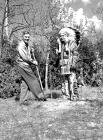
11
The Conservation SpecialsTo attract public attention to the work of the DVCA, Sauriol initiated a series of steam locomotive trips beginning in the Don Valley. The first of these Conservation Specials took place on Sunday, May 13, 1951 and attracted more than 800 participants. Between 1951 and 1961, the DVCA organized 11 such trips, travelling to Mount Albert, Vandorf, Niagara Falls, Cobourg, Uxbridge and Lindsay, Ontario.
This photo was taken on May 18, 1952 during the second annual Conservation Special trip to Mount Albert. Jasper Hill, known as "Chief Big White Owl," was the associate editor of the "Native Voice." His address emphasized the importance of understanding and preserving nature.
